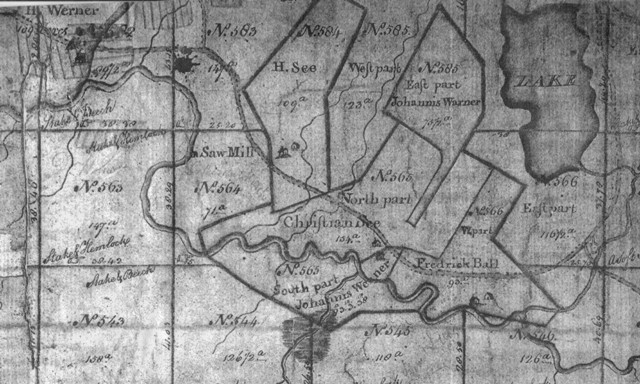Zeh Family

The earliest records of the Zeh family have been traced to Rudelsheim, a village replaced in 1830 by Ludwigshöhe, just south of Oppenheim, Germany.
- 1709 Johannes Zeh, aged 42 and his wife Magdalene and three young sons arrived as refugees in London. His occupation was recorded as husbandman and vinedresser. They were Catholics. Later that year Queen Anne decreed that only Protestant refugees could be relocated in the British American Colonies in the New World; Catholics were given the opportunity to either become Protestant or to be shipped back to the Continent. Zeh became Lutheran.
- <1765 Johannes Zeh brought his family from Schoharie to the Beaver Dam and settled next to the Warner family between what are now the hamlets of Berne and East Berne. Like all early Berne settlers the Zeh's were squatters. The two families operated a sawmill on Fox Creek just upstream from the intersection of Turner Road with Helderberg Trail. A book on the history of early mills say that Warner's Sawmill was built in 1765. However, according to 1787 Van Rensselaer records it was operated by both the Warner's and the Zeh's.
- 1765 - The Zeh’s brought with them their Lutheran faith. The first of Lutheran service held in Beaver Dam was in February 1765 when Dominie Sommer of Schoharie preached at the home of Johannes Zeh and administered communion. He administered communion again at the Zeh home in 1766.
- 1790 the first Lutheran church in Beaver Dam was incorporated one of the three trustees was Christian Zeh, a son of Johannes, at whose house Dominie Sommer had administered Communion in 1765. Since there was no hamlet in the area, the simple frame church was built near the Zeh and Warner homesteads, just east of the present-day Pine Park residential area (site of the Pine Grove Cemetery).
- 1787 Stephen Van Rensselaer III had William Cockburn survey his land in the Helderbergs. The purpose was to force leases on the squatters who had been living there rent free, some of them for almost half a century, and to mark 160 square acre lots on the vacant land prior to seeking renters. Survey notes for Lot 564, the site of the present day Pine Grove Park residential area, say: This is a Middling good Lot, Well Watered by the foxen Kill on which is a fine Sawmill, with a gang of Saws. The Werners & See's [Zehs] are the Chief proprietors of it. Chiefly Pine & Oak Timber.
Werner is the original German spelling of Warner. See is an alternative English spelling of Zeh. Names in quotes are the spelling in the original document.
The 1787 survey map shows the Warner and Zeh sawmill on the bank of the Foxenkill on the western edge of the 71 acre lot 564. The lot's irregular shape indicates that it was settled by squatters before the survey. H. See lived on the adjoining lot 584 to the east. Between Helderberg Trail and the Foxenkill was the north part of Lot 565 farmed by Christian See.
The 1787 survey map shows a house on Lot 582 that is still standing (across the street from what in 2007 is the Hilltowns Senior Citizens Center). Although it was reportedly built in 1795 by a Zeh, the Van Rensselaer lease records and 1787 survey map indicate the house was built prior to 1787 by Henry Warner.
On the eastern part of the sawmill lot was the Zeh and Warner families burying ground with the earliest known burial 1777. The Zehs and Warners were instrumental in the 1790 incorporation of what became the Zion Lutheran Church in Beaver Dam. July 1797 the church leased lot 564 where the sawmill and burying ground were located. Using planks sawed at the mill, a frame church was constructed near the burying ground, now known as the Pine Grove Cemetery.